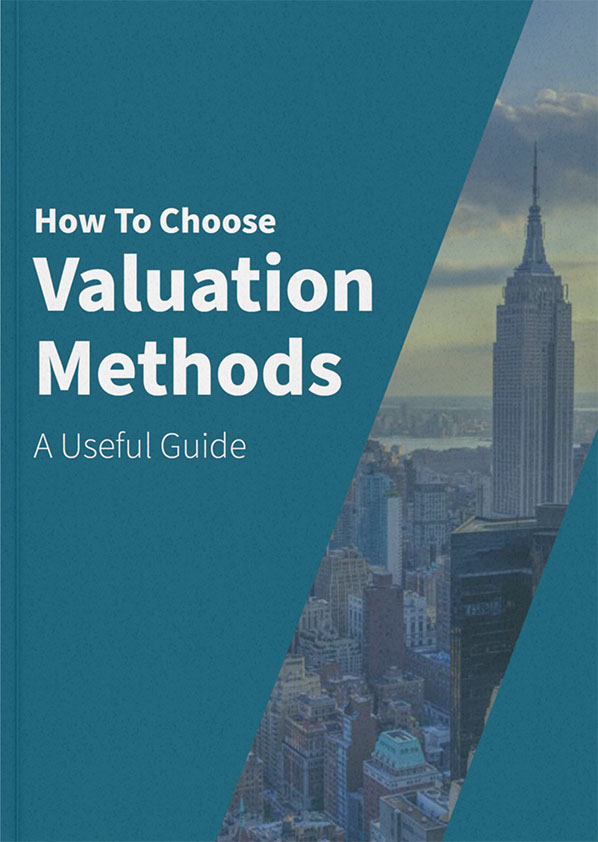Weighted Average Cost of Capital Explained – Formula and Meaning

In this article, we’ll explain what the Weighted Average Cost of Capital (WACC) is, by breaking it down into its components, and highlighting its role in valuing a company through the Discounted Cash Flow method (DCF).
What is the Weighted Average Cost of Capital (WACC)? Determining a company’s “Cost of Capital” is vital in corporate finance and valuation, and the Weighted Average Cost of Capital (WACC) provides a specific way of doing so. WACC considers the costs associated with different components of a firm’s capital structure, such as debt, equity, and preferred stock, and weighs them according to their proportion. These costs are then combined into a “weighted average” which represents the overall cost of financing a business. WACC is a valuable tool in discounted cash flow analysis for finding the value of a company.
First we provide a quick WACC overview, then we explain step-by-step how the WACC works.
QUICK OVERVIEW
- The Weighted Average Cost of Capital (WACC) is a popular way to measure Cost of Capital, often used in a Discounted Cash Flow analysis to help value a business.
- The WACC calculates the Cost of Capital by weighing the distinct costs, including Debt and Equity, according to the proportion that each is held, combining them all in a weighted average.
- The resulting WACC represents the average cost of all the types of capital a company uses to finance its operations.
- The WACC is used as the discount rate in a DCF analysis.
- The higher the WACC, the higher the discount rate, and so the lower the value of the business.
- WACCs in certain industries may be higher or lower in general, depending on the risk associated with that industry. Riskier industries, may have a higher Cost of Capital.
What is the WACC? A Short Summary
The Weighted Average Cost of Capital (WACC) is an important tool for business valuation. It is a metric used to calculate the Cost of Capital for a company based on its specific financing mix (debt, equity and/or preference shares). The Cost of Capital is then used to discount future expected cash flows to arrive at a present value – the valuation of the business using the Discounted Cash Flow method, a leading valuation technique.
The WACC formula derives the current cost of each form of finance, starting with the risk-free rate, the expected return on equity, and the costs associated with debt financing. To calculate the WACC, you must first determine each source’s “costs,” which are expressed as percentages. You then weigh each source by its relative importance in terms of debt or equity.
In order to understand this, it may help to know the following:
What is the Cost of Capital?
The Cost of Capital is how much it costs to obtain debt and equity capital, which is used to finance the operations of a business, including business growth. This is an important metric in business and finance. Businesses that are considered less predictable or more risky may have to face higher costs to obtain capital, as the providers of capital consider themselves taking onboard extra risk of losing their money, and want to be rewarded for their exposure to this risk.
Why is Cost of Capital Important for Business Planning?
Broadly speaking, the company’s Cost of Capital shows how much money new endeavors must generate to offset these upfront costs, in order for the business to generate money.
Cost of Capital is important in business planning as it represents the minimum return a company must earn on its investments in order to satisfy its creditors and equity investors. This helps the company determine the feasibility of new projects and investments, set a proper pricing strategy, and make informed decisions on allocating resources. By considering the Cost of Capital, a company can ensure it is using its funds in the most efficient manner and maximizing returns for its stakeholders.
Cost of Capital vs. WACC
The cost of capital is the total cost of debt and equity that a company incurs to run its operations. This method doesn’t consider the relative proportion of each source of financing. WACC, on the other hand, goes a step further by considering the proportion of each financing source used by the company.
How is the WACC Used?
The Weighted Average Cost of Capital, and its related concept, Cost of Capital, are used when making important financial decisions, including for mergers and acquisitions, investment decisions, as well as evaluating a company’s financial performance and stability.
How Do You Calculate WACC?
To calculate WACC, one must first find the cost of debt and then determine the required rate of return for equity.
In order to calculate WACC, we use the following equation:
WACC = (E/V x Re) + ((D/V x Rd) x (1-T)).
In this equation, “E” stands for “Equity”, “V” stands for “Value”, “Re” stands for “Required Rate of return for Equity”, “D” stands for “Debt”, “Rd” stands for “Cost of Debt”, and “T” stands for “Tax Rate”.
The cost of debt, or Rd, is the rate at which a company can borrow money from its creditors. This rate is typically determined by the length and size of the loan, as well as credit ratings associated with the company.
The required rate of return for equity (Re) is generally calculated using the Capital Asset Pricing Model (CAPM). This model takes into account a variety of factors, such as risk-free rate, beta, and expected market returns.
Finally, tax rate (T) represents taxes associated with interest payments on debt or dividends on equity.
WACC – Key Components
WACC is calculated using a variety of factors, including these main factors.
Cost of equity (or “discount rate”), which considers the expected rate of return given current market conditions and the risk associated with investing in the company.
- Beta factor:
The beta factor is part of the Weighted Average Cost of Capital (WACC). It is a measure of the volatility of a stock in relation to the market as a whole. The beta factor is used to calculate the cost of equity in the WACC formula and is a measure of a stock’s systematic risk, or the risk associated with the overall market. A beta of 1.0 indicates that the stock moves in line with the market, while a beta greater than 1.0 indicates a stock that is more volatile than the market. A beta of less than 1.0 indicates a stock that is less volatile than the market. The higher the beta, the higher the required return for the stock, and the higher the cost of equity in the WACC formula.
Cost of debt is typically determined by interest rates on loans or other financing instruments.
Sometimes, other factors are considered, such as:
Preferred stock that a company may have issued, which pays out dividends at predetermined rates regardless of how well a business is performing.
Weighted average shares outstanding which reflects how many shares are currently outstanding for each type of security held by investors.
Valuing a Business – WACC in a DCF
Weighted Average Cost of Capital (WACC) is an important concept when it comes to valuation. WACC is essential in a Discounted Cash Flow (DCF) analysis, as it serves as the “discount rate”. A DCF requires projecting future cash flows and then discounting them back to their present-day values using the WACC rate as the “discount rate”. The sum of all projected future cash flows (discounted by the WACC) gives an estimate of the “fair value” for a company.
What Does a High WACC Mean?
WACC is calculated as a weighted average of all sources of capital, including debt and equity, used to finance investments. A high WACC indicates that financing costs are higher and reduces the valuation of any given project through discounted cash flow analysis. It also means that investors may be less willing to allocate funds to such projects due to the high cost associated with them. In conclusion, a high WACC can have serious implications on an organization’s ability to obtain funding and accurately evaluate potential investments or projects. Understanding the impact of WACC is key when considering a company’s overall financial health and future prospects.
What Does a Low WACC Mean?
A low WACC is beneficial to any company and its stakeholders. It represents the rate of return that a company must pay for all its financial sources such as debt and equity. A lower WACC means that there is less risk associated with the financing and so the expected return on investment (ROI) will be higher. This makes it more likely for shareholders or other financiers to invest in a company as they have confidence in their returns.
Having a low WACC can also have implications when it comes to valuation. Low Cost of Capital lowers the discount rate used in discounted cash flow models meaning there is an increased value for future cash flows leading to higher valuations for firms with lower Cost of Capital. A low WACC is important for any company’s financial performance and is something that should be monitored closely. Companies should strive to maintain a low Cost of Capital in order to attract investment, reduce the risk associated with their financing and significantly increase their valuation.
Do Different Industries Typically Have Different WACCs?
The industry in which a firm operates can have a significant effect on its WACC. Industries with higher levels of risk often require companies to take on more debt or pay higher interest rates when borrowing money, resulting in a higher WACC. On the other hand, firms operating in less risky industries may have access to lower cost financing options and consequently have a lower WACC.
For example, some of the industries with the highest WACCs include telecommunications, technology, utilities, media, pharmaceuticals, and oil & gas. These industries tend to require significant investments in research and development in order to remain competitive and therefore demand higher returns for investors. On the other hand, industries such as retail, transportation services, leisure/hospitality and banking typically have lower WACCs due to their relatively predictable business operations and low levels of risk.
Ultimately, it is important for companies to understand their individual WACC as well as how it compares to those in their industry in order to gain insight into their financial health and potential value. By analyzing the WACC, firms can gain a better understanding of their overall financial position and make more informed decisions when it comes to investing in growth and other opportunities.
Making Investment Decisions Based on the WACC
The WACC is expressed as a percentage, like interest of return on an investment. If a company has a WACC of 8%, this would mean that company should make investments that give a higher return than 8%, in order to grow. Any investments that give a lower return than 8%, may mean that it is therefore costing the company more money to finance its operations, than it is making from the operations themselves.
The Weighted Average Cost of Capital helps investors make informed decisions about where to allocate their resources for maximum return on investment.
Investing in a Company: WACC is used for this purpose as it takes into account both debt and equity financing costs and in this way provides a measure of required return for investors in order for them to be willing to invest in a company. This is because higher WACC means that the Cost of Capital is higher and the investor will demand a higher return on their investment to compensate for the increased risk. Thus, knowing the WACC of a company can help investors make more informed decisions when investing in that company.
WACC Example
For example, say a company has total equity of $400 million with a cost of 12% and total debt of $600 million at a 6% cost. The WACC can be calculated by weighting these components appropriately:
WACC = (.4 x .12) + (.6 x .06) = 9.0%
This tells us that the company must earn an expected return of at least 9% on any new investments in order to create value from its capital structure. This is a critical metric for investors to analyze when assessing a company’s discounted cash flow or overall valuation.
What are the Limitations of WACC?
Although WACC is a valuable tool for valuing companies, it has some drawbacks. The calculation of several elements in the WACC can be subjective and subject to different interpretations, leading to varying results among analysts. For instance, the effective tax rate or risk-free rate may be calculated differently or based on proprietary methods.
Therefore, it is crucial to use the WACC in conjunction with other financial instruments when assessing valuations. While it is useful in determining the minimum acceptable return on investment, other factors such as market conditions, competition, and company-specific risks should also be taken into account. With a platform like Valutico, a broader range of tools can be used to perform a more thorough and detailed analysis of companies.





